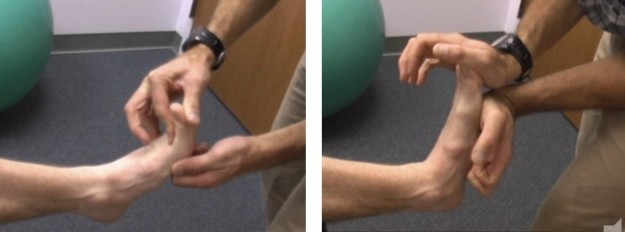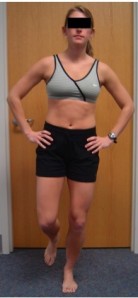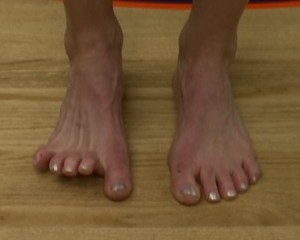There has been a lot of interest lately in the transition to minimal footwear. Am I going to get hurt? How long does this transition take? Is this really better for me? Will my old shoes take it personally? Last year at this time, there were 6 minimal shoes on the market. This year there are 64. It’s a hot market, and folks are taking notice. While shoes are nice to talk about, let’s not forget that it’s the runner in the shoe that plays an active role in this equation. Shoes don’t run by themselves!
The recent article by Giuliani et. al. has raised some concerns.2 They highlight 2 cases of stress fractures in 2 different runners who transition to minimal footwear. The switch to minimal footwear can be dramatic. You get more “feel” since the squishy midsole is reduced or gone. You get a lower differential from your rear foot to your forefoot. These 2 factors change a) the position of the foot (Heel isn’t higher than the forefoot in full contact) and, b) the demand of the runner to stabilize the foot inside the shoe. In short, with less “stuff” in between you and the ground, you need your body to do a bit more, and get accommodate to a bit more as well.
Ever hear about the experiment with pre-K kids with the cookies? They put a kid in a room with cookie on the table and tell him/her that they can eat the cookie and they’ll get one cookie. BUT, if they don’t eat the cookie, they’ll get 2 cookies later (yea!). The tester walks out of the room and the kids go into panic mode when sitting in front of this stellar, delicious cookie. Most eat the single cookie for instant gratification. They fail to see the merits of waiting patiently for a better result.
What in the world do cookies have to do with running shoes? A lot. The switch to minimal footwear can pay off in the long run, but you need ensure you’ve got what it takes for a successful transition. Obviously any time you make a change to your body, there is an adaptation period that needs to occur. A lot of “experts” say that it will take 6 months to a year to fully transition to a minimal shoe. I’d like to think that this is overly cautious, and like to discuss why using the anatomy. We’ve found great success using the following 3 criteria for runners looking to run with “less”.
1. Mobility: Traditional running shoes have about a 10-13mm drop from the heel to the forefoot. This creates a “rocker” effect in the shoe. Take a look at a shoe from the side and you’ll see that the curve from the ball of the foot to the tip of the toe rises up. Since your foot is flat, you need to ensure that you have enough mobility (called dorsiflexion) of the big toe to allow the foot to roll over. Additionally, since the heel is higher in a traditional running shoe (think a small high heel) the heel chords are used to operating in a shortened position. You need to ensure that you’ve got the mobility needed to allow the heel chords to operate form their slightly lengthened position. So what to you test?
- Ankle mobility (heel chords) – you need to be able to dorsiflex (cock the foot up towards the shin) about 25 degrees. Lack of mobility here means you’ll need to stretch the calf and Achilles.
- Plantar facsia mobility – with the ankle in about 5 degrees of dorsiflexion, you need to have 30 degrees of dorsiflexion at the big toe. If you don’t have this, you can’t roll over the toes, and will be forced to spin off of the forefoot.

2. Single-leg Standing Balance: normal balance has been identified as standing on single leg for 30 seconds
with a still upper body and full foot contact. Since the midstance phase of running is essentially a single leg squat, it is essential that the runner is able to maintain the foot in contact. A triangle between the inside ball of the foot (1st MTP), end of the big toe (distal phalanx of the 1st ray), and outside ball of the foot (5th MTP) should be seen. When in single leg stance, the muscles in the foot need to be “pro-active” not “re-active”. If you are wobbling your foot back and forth when standing on one foot, you’ve got some room to improve your “proprioception” – or sense of where and what you’re your foot is doing during contact. The most successful way to improve single leg balance is to perform it frequently (15-20 times a day) for small doses (30 seconds each).
3. Ability to isolate the Flexor Hallucis Brevis: a key factor that distinguishes humans from primates is our medial longitudinal arch. This arch is actively stabilized by the flexor hallicus brevius (FHB). While standing, try to drive the big toe (1st MTP) into the ground (plantar flexion) while slightly elevating (dorsiflexing) the lesser toes. Make sure not to roll the ankle in or out. This test enables screening of muscles inside the foot that stabilize the arch. The FHB can be easily distinguished from the longus (FHL), as the FHL crosses another joint in your big toe (1st IP joint), resulting in your big toe curling. Spend some time getting to know your foot. Aim to drive the big toe down while lifting the little toes (without curling the big toe!), and lift the big toe up while driving the little toes down. It’s the best way to work on coordination of muscles that actively stabilize the foot in stance. It’s your foot – control it! If you can do this, it’s a sign that you can keep the rear foot stable on the forefoot when the body sees the greatest amount of pronation (which is just slightly after midstance and AFTER the heel is off of the ground by the way.)1 Midstance is when forces are highest throughout the body- about 2.5x’s your body weight. You need the internal strength to be able to respond to these forces to keep things in alignment.
When your foot “works” it can actively stabilize the transfer of forces through the foot. If you don’t pass these 3 tests, no worry -get to work on improving your limitations. Pay a visit to your local PT if you need help with specific exercises and stretches to improve. If you lack mobility, research shows it takes 10-12 weeks to gain significant improvements. So stretching for 2 weeks likely won’t be enough for most folks. Improving tissue length can take some time. If your limitations are in the balance aspect, you’ll be amazed how quickly this improves if you simply practice practice practice. Typically, about 2 weeks yields a significant improvement. Finally, strength gains take about 6-8 weeks to achieve. So if you really have trouble isolating your foot muscles, this could take a bit to get them stronger – but you can always improve the strength of your muscles! Passing these 3 tests doesn’t mean that you should go run a marathon in your new minimal shoes on day 1, but we’ve seen that folks who master these have little to no problem making the transition. I’ll note here that these tests are not new in my mind. I’d like all runners – even those who run in traditional shoes – to pass these tests. Its that when the “stuff” under your foot is less, these traits are that much more important.
So invest some time to improve your foot – Because it’s always better to have 2 cookies instead of one! Shoes make a difference, but it’s the runner in the shoe that you’ve got control over.
References:
Dicharry, JM., Franz, JR., Della Croce, U., Wilder, RP., O’Riley, P., Kerrigan, DC. Differences in Static and Dynamic Measures in Evaluation of Talonavicular Mobility in Gait. J Orthop Sport Phys Ther 2009;39(8):628-634
Giuliani J, Masini B, Alitz C, Owens BD. Barefoot-simulating Footwear Associated With Metatarsal Stress Injury in 2 Runners. Orthopedics. 2011 Jul 7;34(7)

Pingback: Ask the Experts: How Much Time Do I Need to Transition to Minimalist Footwear? | Natural Running Center
Excellent post, one I wish I had read a year ago. I had blazed ahead onto minimalist shoes and had a string of minor injuries. I finally saw a doctor and he noted that I had very limited ankle mobility which led to all sorts of strange contortions to compensate and they in turn led to injuries.
I’m working on mobility now but for months I had just chalked it up to “too much too fast” without realizing that there was a deeper problem.
Good blog! I totally agree that people depend on instant gratification to much. Patience needs to be the virtue to practice
Pingback: Barefoot Flexibility | Barefoot Journey
Question on #1. Is the flexibility based upon the ankle (or toe) being flexed by a helper (like in the pics) or is it me being able to do it myself (ie flexing my own ankle rather than pushing it). Huge difference for me.
Hi Josh – its based on passively moving the toe. Yes -you are right – big difference in the active and passive mobility here.
J
Pingback: Criteria For a Safe Transition to Minimalist Shoes or Barefoot Running: Thoughts From Jay Dicharry, PT | Road Runner Shoes
Any advice on how to work on isolating the FSB? I just tried this and can’t do it at all — I can only move all my toes (inluding the big toe) together. Just keep trying until it starts to work?
Check out my forthcoming article in the April Ed of running times. Lots of good word in print, and a great video on their website as well
I loved this post thanks!
I started transition to minimal shoes about 10 months ago, VFF. Six months ago I got a stress fracture on the left side, of the cuboid bone, and I haven’t been able to run since, its still healing. I have read online that it is very unusual to fracture this bone in isolation, but I somehow I managed it.
I tried the three exercises. Number 1 I did great! Number two, balancing, I did terrible. On the right side I can keep standing up but only with lots of wild wobbling, on the left side can’t even count to three before I have to put the right foot down or fall over. Number 3 I did OK, but it is markedly better on the right side than left.
I know its anecdotal but my experience seems to prove your point, I am convinced that my lack of balance, and much stronger lack of balance on the left side, played a role in my left side fracture.
Well I know what I have to do… lots of balancing
Pingback: 3 reasons why I train my feet. | train your feet
Thanks, Jay, for another interesting and informative post on this blog!!
I also read the Giuliani et. al. article cited in the post, and think this is a helpful reminder that it can be risky to change one’s running too quickly and/or without proper preparation.
However, I don’t agree with the authors’ statement that we can presume these 2 runners who developed stress injuries “likely continued running with a hindfoot strike as they transitioned to barefoot-simulating footwear…” If their gait wasn’t analyzed before and after their shoe change, then we don’t actually know if they ran with a heel strike while wearing the different shoes. Furthermore, landing on the heel while running barefoot is uncomfortable, so it seems to me that most people wouldn’t continue that for weeks.
I totally agree with this post. We are conditioned to shoes and it takes time and effort to adapt to the changes in stresses, particularly increased loadings on the achilles and calf muscles. I’m also convinced that there is a world of difference between ‘barefoot running’ and running in any form of ‘barefoot shoe’, no matter how thin soled, since any covering on our feet constitutes a shoe to our ‘shoe-conditioned’ nervous system. Not only do we have to train our bodies to adapt to barefoot running, but also we have to actually go barefoot right from the start and forego the shoes, and only allow ourselves minimualist shoes when we are happy running barefoot – by which point we may not want barefoot shoes anyway!
I just don’t think there is a way you can work down to barefoot running since until you actually take you shoes off, your nervous system is telling you that you have shoes on and your running style just does not adapt enough. The human body is great at adapting, but it requires feedback to adapt and by running barefoot and accessing the novelity, perhaps discomfort, and the psychological factor, does this prevent the runner from carrying on with a style that is only acceptable whilst wearing cushioned shoes.
However before anyone gets the idea that this is an evanglical post about the absolute certainty of barefoot running and how it can be a panacea for all injuries, I’ve been barefoot running since the age of thirteen – caused by living near the great barefoot runner Zola Budd as a kid – and I suffer from achilles problems and AJP. But it’s worse if I put shoes on because it allows me forget about my feet.
Andy, UK
Pingback: Ask the Experts: How Much “Time” Do I Need to Safely Transition to Minimalist Footwear? By Jay Dicharry | The Art of Fitness - Austin Deep Tissue Massage Therapy
Pingback: A New Day « Not quite Kenyan…
Pingback: Barefoot Running Blisters: Interpreting My Pattern and the Importance of the Flexor Hallucis Brevis? | Road Runner Shoes
Pingback: Tuesday October 4th, 2001 | Core CrossFit Downtown Phoenix Arizona
Pingback: one leg under the mistletoe « Uvaendurosport's Blog
Pingback: Transition-test • (Almost) 50 and Running
A motivating discussion is definitely worth comment. I think that you need to write more on this subject matter, it may not be a taboo subject but generally people do not speak about such topics. To the next! Kind regards!!
Pingback: Foot Function, Ankle Dorsiflexion, and Minimalism – Oh My!–Guest Post by Greg Strosaker | Run Sweat Tears
Pingback: Foot Function, Ankle Dorsiflexion, and Minimalism – Oh My!–Guest Post by Greg Strosaker | Get Fit Bookmark
Reblogged this on Run for Something and commented:
When it comes to running biomechanics, I’d say Jay Dicharry is an expert. I almost figured out how to get my healthcare to pay for a session at the SPEED Institute, but didn’t get it done before I moved to AK. If you’ve asked yourself, “Am I ready to run in minimal shoes?” then this is a great way to test yourself out.
If you’re that guy who decided an overnight switch to Vibrams was exactly what you needed, enjoy this article from the couch while you enjoy your stress fractures.
To test ankle and big toe range of motion, do you recommend keeping the knee straight or bent? Straight knee would demonstrate the length of the gastroc, bent would demonstrate the length of the soleus. I’m not sure if bending or straightening the knee would affect plantar fascia lengthening…
hi Christina –
to be most accurate, keep the knee slightly bent. In running athletes, the knee is always bent during the contact phase so the gastroc is never the limiting tissue.
Best – J